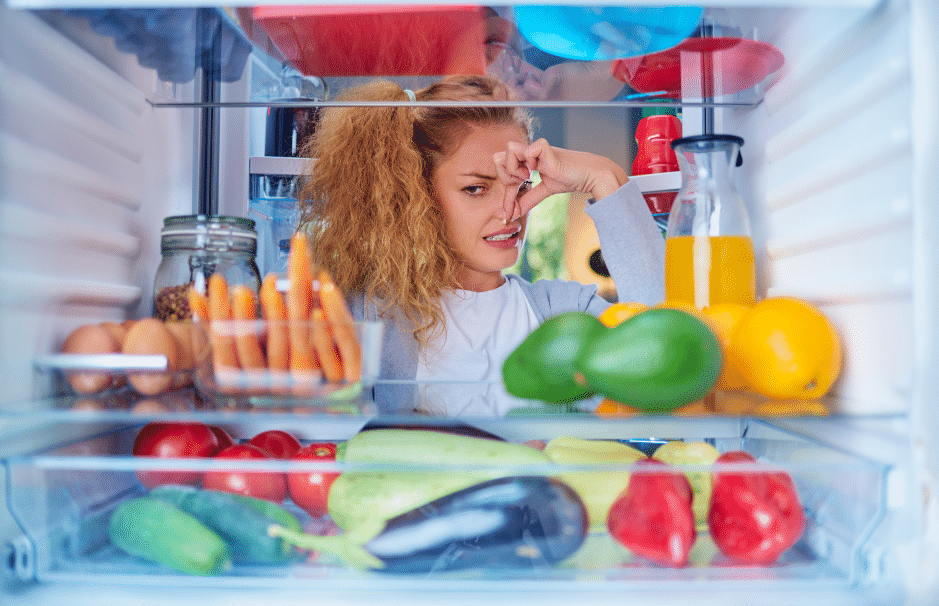I am not happy with whomever invented Clean Out Your Fridge Day which is “celebrated” on November 15. Do we really need to be reminded that although the rest of our place looks presentable, there’s probably something creepy, hairy, stinky, and unknown lurking in the back corner of the crisper drawer? Clearly, we do, or this day would not exist. My fridge is like my closet. It will go for weeks – dare I say months – looking tidy and clean and then suddenly, out of seemingly nowhere, it looks like elves performed some horrible mischief in the night. My once neat, organized, color-coded (yes, I am THAT girl) closet is a sloppy wreck with clothes falling off the hangers and the fridge contains mysterious science-fair-like “stuff”. And it’s not like cleaning either the fridge or the closet is hard; it’s just an annoyance and an awful way to spend a Saturday morning when you could be brunching on eggs benedict and sipping mimosas. So what is one to do? As in the words of a dear friend of mine, “Just git ‘er done”. Here’s a few tips on making this god-forsaken process a wee bit less miserable.
Preparation
Obviously, you have to remove all food from the fridge to clean it. Short on counter space? Set up a little folding table or use a few chairs. I am pretty successful with just removing food from one section at a time, cleaning it, and putting it back before moving on. For a complete, and uber-thorough clean (completely emptying), put your food in a cooler. You’ll need at least enough room to hold a shelf’s worth of stuff. Make sure your kitchen sink is empty, too. While you’re at it, put the recycling bin and trash can nearby as you’ll likely be tossing expired items and items that no longer resemble food.
Supplies
You won’t need much: white vinegar and/or dish soap; a spray bottle or a big bowl; a sponge and/or a scrubby; and paper and/or microfiber towels — all or most of which you probably already have on hand (whew). The vinegar breaks down grease and grime, and when mixed with hot water in a spray bottle (or bowl, or dishpan, or bucket), it becomes a food-safe cleaner that’s perfect for any gunk that might have accumulated on refrigerator shelves. The other items on the list will help you wipe, scrub, dry, and shine.
The Process
While some people have enough counter space (is there ever really enough?!?) to completely empty their refrigerators before cleaning, I find working one shelf at a time is often the best method, because you don’t want to leave your perishables out for too long.
- Start at the top.
- Remove everything from a shelf and see just how messy you (or those darn elves!) have been.
- If there are spills, carefully remove the glass from the frame or brackets, or the shelf itself (depending on your fridge) and clean both sides, as well as the edges, with the vinegar solution.
- Dry with paper or microfiber towels.
- Wash the frame that holds the glass before replacing the entire shelf. For that, I usually head to the sink and use dish soap and hot water.
- If there aren’t any caked-on spills that require shelf removal, simply run a scrubby sponge under hot water. Give the shelf and fridge walls an initial scrub to loosen any gunk. Then, spray it all down with cleaner and give it another scrub, before wiping everything clean with a microfiber cloth.
NOTE: When you’re not actively working in the fridge, keep the door closed to keep everything as cool as possible.
Doors and Drawers
Refrigerator drawers often accumulate debris, especially if they’re used for produce. For a deep clean, remove the drawers and wash them in the kitchen sink with soap and water. If they won’t fit in your sink, spray and wipe them clean, and dry them before putting them back. While the drawers are removed, wipe down the walls and “floor” of the fridge with the vinegar cleaner. Use the same method for the shelves inside the doors.
Put Stuff Back Clean
Now that your fridge is sparkling (and you realize it wasn’t THAT BAD to clean), be sure to wipe down jars, containers, and condiment bottles so you don’t bring gunk back into the fridge. Even if they don’t appear dirty, it’s a good idea to give container bottoms a quick wipe with a damp sponge or paper towel, especially if the shelf was sticky. If any bottles or jars have accumulated a little goo on the outside, rinse them under warm water then wipe them clean and dry. If gunk has accumulated around the seal or the edges of the cap, take the lid off and wash it more thoroughly in the sink. Check all expiration dates and toss anything that’s expired (like the sriracha I just threw away from 2017. Yikes.)
Wipe Down the Outside
Once everything is back in your sparkling fridge, use a clean microfiber cloth and the vinegar spray to wipe down the outside of the doors, including the edges and seals, and don’t forget the handles! The worst area will undoubtedly be to top of the fridge as it tends to collect greasy residue from cooking and dust. I like keeping a kitchen towel on top that can just be thrown in the wash. If you have a stainless steel fridge, spray on a cleaner specially made for stainless steel and polish with a microfiber towel for a streak-free finish.
Keep It (and Yourself) Fresh
You did it and you lived to tell the tale! Enjoy your super-clean fridge. For a while, anyway. If you want to keep it smelling fresher longer, stick an open box of baking soda on one of the shelves. Now treat yourself to brunch with a bloody Mary. You deserve it.

Leave a Reply